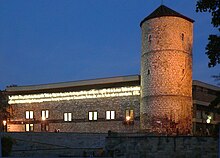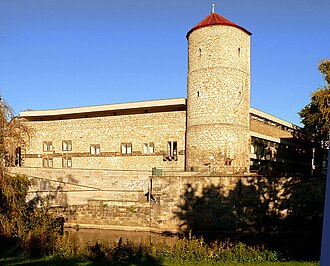Historical Museum Hannover
The Hanover Historical Museum brings together holdings on the history of the city of Hanover and the former Guelph areas of today's Lower Saxony .
history

Postcard 1 , Series B ; Georg Alpers jun.
The museum - sponsored by the City of Hanover - was opened on April 26, 1903 as the Fatherland Museum in the Cumberland Gallery . It was founded on the initiative of the Heimatbund Lower Saxony . In 1937 the museum was renamed the Lower Saxon Folk Museum . It was destroyed in 1943 by the air raids on Hanover in World War II. In 1950, the provisional reconstruction began under the provisional name of the Lower Saxony Museum of Local History . In 1966 the museum was opened under its current name in the new building designed by the architect Dieter Oesterlen . The Association of Friends of the Historical Museum supports the work of the museum financially and ideally.
In 2017, the museum's permanent exhibition, conceived in 1993, was redesigned. In 2020 the museum will close for three years for renovation work.
location
The head office of the museum is located on the Hohen Ufer der Leine , the place where the medieval settlement of Hanover is believed to have begun in the 11th century. This was a place at the Leine crossing of the trunk road between Hildesheim and Bremen , which was secured here by a feudal yard. Even if the derivation of the name of the city “Hanovere” or “Honovere” from the “high bank” should not apply according to the latest scientific findings, the museum has a unique location in the area of city development.
The Begin Tower integrated into the museum is the last completely preserved city wall tower of the medieval city fortifications of Hanover . The museum also uses the high quarry stone wall of the ducal armory, which was built between 1643 and 1649 . The wall facing the Hohe Ufer is a section of the city wall. When significant medieval finds were made in 2013 in the area of the Hohe Ufer during construction work on a property adjacent to the museum, this led to a three-month urban archaeological investigation on the Hohen Ufer . Opposite the museum is the “traditional island” of Hanover's historic old town with Burgstrasse, consisting of numerous half-timbered houses reconstructed in the 1960s, as well as the rebuilt Leibnizhaus on Holzmarkt.
building

The museum building was built as a new building from 1964 to 1967 according to plans by the architect Dieter Oesterlen . The Begin Tower and the rest of the ducal armory were included on the site of a block of flats in the old town that was destroyed in the war. The museum has a polygonal floor plan around a pentagonal inner courtyard, the distinctive facade shows alternating wide sandstone surfaces and narrow ribbon windows on three floors as well as a graduation from the perspective of the northern Burgstrasse. In 1991 it was rebuilt, and in 2002 the individual departments were redesigned. This concerned the regional history department on the ground floor and part of the town history on the first floor.
The text of the illuminated quotation by Gottfried Wilhelm Leibniz on the Leibnizufer side - a light installation by the American conceptual artist Joseph Kosuth - reads:
"There is no desolation, nothing sterile, nothing dead in the world, no chaos, no confusion, except for an apparent one, something like what seems to prevail in a pond if one saw a confused movement and, so to speak, a swarm of fish, from a distance, without distinguishing the fish themselves "
Collections
Departments
The museum is divided into the following sections:
- From principality to kingdom: the development from the principality of Calenberg around 1600 to the end of the kingdom of Hanover in 1866 is shown.
- From a market town to a trade fair city: over a period of 750 years, Hanover developed from a settlement to den hogen overen to a large city.
- Life in the country: It shows how the rural population of Lower Saxony lived from the 17th to the 20th century.
- In Herrenhausen Palace which was in May 2013 Schloss Herrenhausen opened as a new department of the Historical Museum Hannover.
Guided tours of the museum take place on Sundays.
Photo archive
The museum is one of the largest photo archives in Germany: it holds around 1,000,000 historical photos for inspection and purchase of reproductions. According to the presentation of photo heritage , the museum has a collection of more than 5,000,000 photos.
Medals and medals
The politician and banker August Basse donated the so-called Finkam collection of medals and decorations to what was then the Fatherland Museum .
vehicles

Some old vehicles are on display in the museum. This includes a Hawa 40 volt small electric car from the Hannoversche Waggonfabrik .
people
From 1928 to 1945 Wilhelm Peßler was director of the Fatherland Museum in Hanover.
literature
- Historical Museum Hannover . In: Dieter Oesterlen: Buildings and Texts 1946-1991 . Tübingen: Wasmuth 1992, pp. 138-147. ISBN 3-8030-0153-6 .
- Waldemar R. Röhrbein : Historisches Museum am Hohen Ufer 1903-1978. In: Hannoversche Geschichtsblätter , New Series 32 (1978), pp. 3-60
- Franz Rudolf Zankl : Exhibition of the guild antiquities in the Fatherland Museum. Photography around 1910. In: Hanover Archive , sheet K 12
- Helmuth Plath : Urban History Department. (= Department catalogs of the Historisches Museum am Hohen Ufer, Hanover. 1). Hanover 1970.
- With history into the future , commemorative publication for the 25th anniversary of the Friends of the Historical Museum , Hanover 2005
- Helmut Knocke , Hugo Thielen : Pferdestraße 6. In: Hannover Art and Culture Lexicon , pp. 178–180
- Thomas Schwark , Waldemar R. Röhrbein: Historical Museum In: Klaus Mlynek, Waldemar R. Röhrbein (eds.) U. a .: City Lexicon Hanover . From the beginning to the present. Schlütersche, Hannover 2009, ISBN 978-3-89993-662-9 , p. 299.
Web links
- Literature from and about the Historisches Museum Hannover in the catalog of the German National Library
- Museum website
- City board of the Historical Museum
Individual evidence
- ↑ Thomas Schwark, Waldemar R. Röhrbein: Historical Museum. In: Stadtlexikon Hannover , p. 299
- ↑ Website of the Heimatbund Lower Saxony ( Memento of the original dated December 2, 2013 in the Internet Archive ) Info: The archive link was inserted automatically and has not yet been checked. Please check the original and archive link according to the instructions and then remove this notice. , accessed November 24, 2013
- ^ The historical museum is being rebuilt in the Hannoversche Allgemeine Zeitung from November 24, 2017
- ↑ Search for magazine: Where should Hanover's treasures be stored? in Hannoversche Allgemeine Zeitung from December 23, 2019
- ^ Leibniz Universität Hannover: Leibniz and Hannover - on the trail of the universal genius, 2nd amended. Ed.
- ↑ Online presentation, point 8 , accessed December 21, 2015
- ↑ Holdings from Hanover
- ↑ Waldemar R. Röhrbein : BASSE, (1) Wilhelm. In: Dirk Böttcher , Klaus Mlynek, Waldemar R. Röhrbein, Hugo Thielen: Hannoversches Biographisches Lexikon . From the beginning to the present. Schlütersche, Hannover 2002, ISBN 3-87706-706-9 , p. 43; online through google books
- ↑ Compare August Finkam: The Badges of Honor awarded to Braunschweig and Hanoverians for war, merit and seniority , Lafaire, Hanover 1901
Coordinates: 52 ° 22 ′ 19 ″ N , 9 ° 43 ′ 53 ″ E



